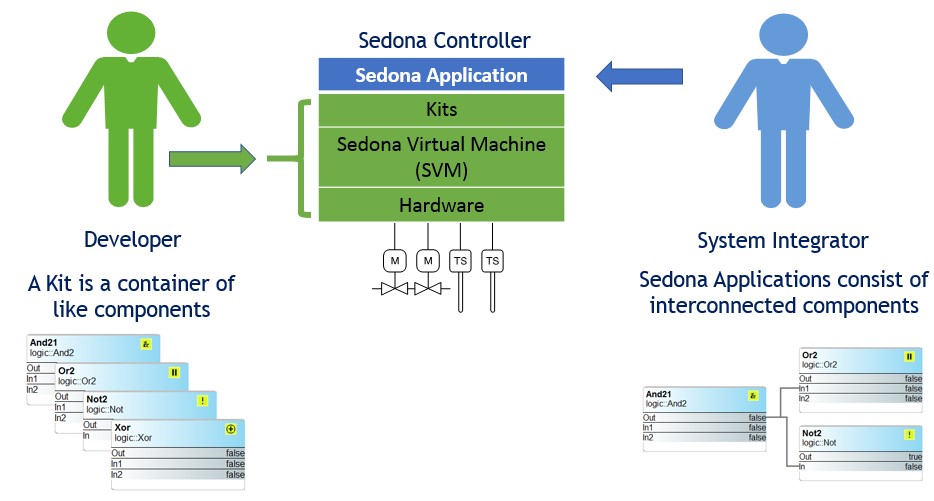
What is Sedona?
Developed by Tridium, Inc, Sedona is an open-source software environment designed to make it easy to build smart, networked, embedded devices which are well suited for implementing control applications. The Sedona language facilitates component-oriented programming where components are assembled onto a wire sheet, configured and interconnected, to create applications. Sedona was made available to the public under an Academic Free License (AFL 3.0) granted by the licensor—Tridium, Inc. A licensee was allowed worldwide, royalty-free and non-exclusive use of the technology.
How are Sedona applications produced?
Using a Sedona tool, components deployed in kits are assembled onto wire sheets creating applications that are executed by a Sedona device. The Sedona language is ideally suited for graphical representation of control strategies. It has a similar look-and-feel to the popular Niagara Framework® and it is IP-based. Those with experience with Niagara Framework will have no problem understanding Sedona. For those without Niagara experience, the graphical representation of components linked on a wire sheet to create applications is intuitive and can be easily learned with a minimum of training.
What comprises a Sedona device?
A Sedona device or Sedona controller consists of a Sedona Virtual Machine (SVM), a collection of kits that include components, and hardware in the form of a processor, memory and input/output circuitry that interfaces to real-world devices. On this platform the Sedona application resides. Sedona developers create the intricacies of the Sedona device while system integrators create applications that run on Sedona devices.

What is a Sedona Virtual Machine?
A Sedona Virtual Machine (SVM) is a small portable fast interpreter that can reside on most any hardware platform or operating system while executing a Sedona application. Depending upon the kits used by the Sedona application, it is possible to run the identical Sedona application on another SVM with a completely different hardware platform and operating system without modification. The original Tridium SVM has been modified by different developers in the Sedona community to run on different platforms such as limited-resource microcontrollers, Linux platforms, and powerful Windows workstations. In fact, an SVM have been developed for the Raspberry Pi. SVMs are intended to operate over IP networks making Sedona attractive for Internet of Things (IoT).
What is the role of the developer?
A Sedona developer is either a hardware manufacturer or a software developer skilled in the use of Sedona. Physical hardware such as CPU, memory and I/O need to be designed to become a Sedona device. The Sedona Virtual Machine must be modified to accommodate the hardware platform. A developer can obtain documentation and the Sedona development files on the Sedona Alliance Resources page.
Custom kits called hardware-dependent kits need to be developed that support the native functions of the platform. On this platform hardware-independent kits can be installed to provide more functionality. Once all elements are put together you will have a Sedona device awaiting an application.
What is the role of the system integrator?
The system integrator translates the required sequence of operation (SOO) into a Sedona application that executes the sequence. The integrator is skilled in creating applications which are created by extracting components from kits, placing them onto a wire sheet, configuring the components if necessary, and interconnecting the components with links. Because of the system integrators' specialized application knowledge, the SI recommends to the developer any custom components that need to be developed that would improve effectiveness of applications. It is in the spirit of the community to share any custom hardware-independent kits.
What is the difference between components and kits?
Components are the fundamental building blocks for creating applications. However, components are deployed into a Sedona device in a container called a kit. Similar types of components are assigned to kits with relevant names such as Math, Logic, HVAC and so on. There are three types of kits:
- Original Sedona 1.2 kits that are part of the Sedona development files available for download on the Sedona Alliance Resources page.
- Custom hardware-independent kits by Sedona developers that can be shared.
- Custom hardware-dependent kits by Sedona developers that cannot be shared.
The spirit of the Sedona Community is to share kits if possible.
Where do I find a Sedona tool?
The original Sedona tool is Tridium's Niagara Workbench 3.37 or 3.38 but with Sedona installed. Other Sedona tools are available from Sedona developers. The Sedona Alliance recommends the Sedona Application Editor (SAE) by community member Contemporary Controls for free by download. Included with the SAE download is a SVM that runs on a PC that can be used to program when evaluating Sedona. A link to SAE can be found on the Resources page.
What is there to like about Sedona?
- The graphical experience of selecting components, configuring parameters, and linking components to create applications is easy to do and to explain to others
- The technology is open source, royalty-free, and supported by several companies so the opportunity exists to share experiences
- A community exists of users who create applications, and developers who make components and virtual machines
- The technology is portable to other platforms and will run on a small micro-controller or a powerful computer
- The opportunity exists to share in the exchange of custom components and kits within the community
- Program debugging is fast because the effect of any change is seen instantly